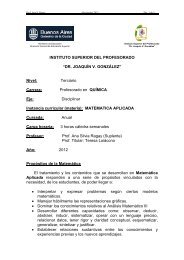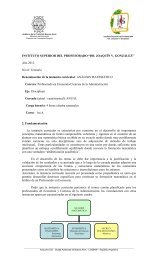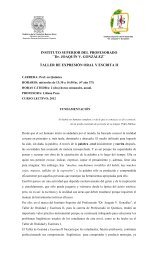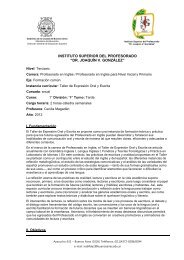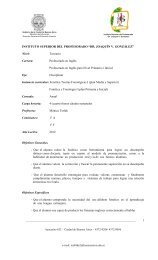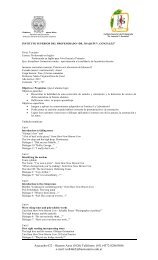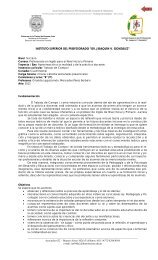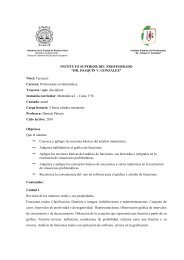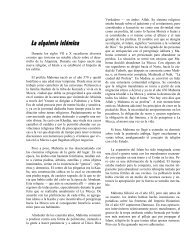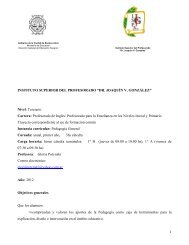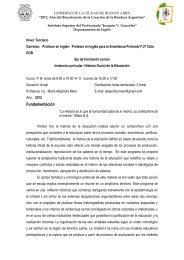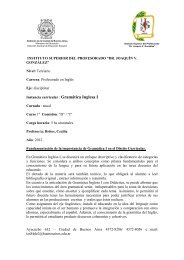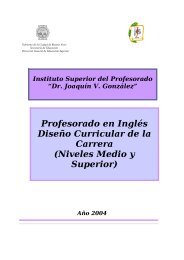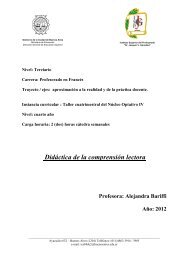Los retos de la historia oral en el siglo XXI: diversidades ...
Los retos de la historia oral en el siglo XXI: diversidades ...
Los retos de la historia oral en el siglo XXI: diversidades ...
You also want an ePaper? Increase the reach of your titles
YUMPU automatically turns print PDFs into web optimized ePapers that Google loves.
Sesiones parale<strong>la</strong>s / Parall<strong>el</strong> sessionsC<strong>en</strong>tro Cultural <strong>de</strong> <strong>la</strong> Cooperación——————————————————————————————————————————————Subtema / Subteme 4Géneros, memoria y política / G<strong>en</strong><strong>de</strong>r, memory andpoliticsSa<strong>la</strong> Aníbal Ponce - Mesa / Session 15Coordinan / Chair: Cristina Viano, Luciana Seminara y RobsonLaverdi——————————————————————————————————————————————VERAS, Elias FerreiraLas <strong>historia</strong>s <strong>de</strong> Sebastiâo-Bianca. ¿Quién necesita<strong>de</strong> i<strong>de</strong>ntidad?En este artículo pret<strong>en</strong>do historizar <strong>la</strong>s multiples posibilida<strong>de</strong>s <strong>de</strong> <strong>la</strong> travestilidad,<strong>en</strong> <strong>la</strong> ciudad <strong>de</strong> Fortaleza (CE), <strong>en</strong> los años <strong>de</strong> 1980. Mi principal fu<strong>en</strong>te<strong>de</strong> investigación es una <strong>en</strong>trevista realizada a Sebastião-Bianca, <strong>en</strong> 2011, utilizando<strong>el</strong> método <strong>de</strong> <strong>la</strong> <strong>historia</strong> <strong>oral</strong>. A<strong>de</strong>más analizo algunos reportajes <strong>de</strong> losperiódicos “El pueblo” y “Diario <strong>de</strong>l Nor<strong>de</strong>ste” publicados <strong>en</strong> <strong>la</strong> década <strong>de</strong> los90. Establezco una comparación <strong>en</strong>tre <strong>la</strong> narrativa <strong>oral</strong> <strong>de</strong> Sebastião-Biancay los discursos producidos por <strong>la</strong> pr<strong>en</strong>sa sobre <strong>el</strong> sujeto travesti, con <strong>el</strong> fin <strong>de</strong>mostrar que fue justam<strong>en</strong>te <strong>en</strong> oposición a esos discursos divulgados <strong>en</strong> losperiódicos y, principalm<strong>en</strong>te, <strong>la</strong> asociación que estos hicieron y hac<strong>en</strong> <strong>en</strong>tretravesti y prostitución, <strong>de</strong> cierto modo todavía compartidos <strong>en</strong>tre <strong>el</strong> común<strong>de</strong> <strong>la</strong>s personas, que Sebastião-Bianca <strong>de</strong>-construye s<strong>en</strong>tidos y significadosre<strong>la</strong>cionados con su propia travestilidad. Al contrario <strong>de</strong> travestis “veteranas”,que <strong>en</strong> <strong>en</strong>trevista sobre <strong>el</strong> “universo travesti” <strong>de</strong> Fortaleza re-afirmaron y reafirman<strong>el</strong> discurso <strong>de</strong> <strong>la</strong> travestilidad, <strong>el</strong> o <strong>la</strong> <strong>en</strong>trevistado-a aún que <strong>en</strong> algúnmom<strong>en</strong>to <strong>de</strong> su vida se haya travestido, no reivindico ni reivindica para si unai<strong>de</strong>ntidad travesti. Sabastião-Bianca se viste con ropas masculinas aunquecontinua si<strong>en</strong>do l<strong>la</strong>mado por su nombre fem<strong>en</strong>ino. Al preguntarle como le gustaríaser tratado-a durante una <strong>en</strong>trevista, respondió: “Como usted quiera, nome importa”. De ese modo, tomo los estudios sobre i<strong>de</strong>ntida<strong>de</strong>s y <strong>la</strong> <strong>historia</strong><strong>oral</strong>, para problematizar <strong>la</strong> sigui<strong>en</strong>te cuestión: ¿Quién precisa <strong>de</strong> i<strong>de</strong>ntidad?LAVERDI, RobsonFamilias homoafectivas <strong>en</strong>tre <strong>el</strong> activismo y <strong>la</strong> vidacotidianaEsta pon<strong>en</strong>cia busca discutir <strong>la</strong> emerg<strong>en</strong>cia <strong>de</strong> experi<strong>en</strong>cias <strong>de</strong> hombres y mujereshomosexuales, constituidas históricam<strong>en</strong>te a partir <strong>de</strong> re<strong>la</strong>ciones afectivasestables. Así, <strong>la</strong> investigación toma por base testimonios <strong>oral</strong>es <strong>de</strong> parejasgays producidas para esa finalidad, <strong>de</strong> personas que viv<strong>en</strong> <strong>en</strong> contextos ytiempos <strong>de</strong> perman<strong>en</strong>cia <strong>de</strong> <strong>la</strong> conjugalida<strong>de</strong> difer<strong>en</strong>ciados. En Brasil, como <strong>en</strong>otras partes <strong>de</strong>l mundo, <strong>en</strong> <strong>la</strong>s últimas décadas <strong>el</strong> activismo LGBT hay ganadomucha visualidad y fuerza <strong>en</strong> <strong>la</strong>s luchas por <strong>de</strong>rechos sociales, o sea conquistandoespacios, haci<strong>en</strong>do pautas <strong>de</strong> dignificación y combati<strong>en</strong>do <strong>la</strong>s formas<strong>de</strong> discriminación y homofobia. Aunque no hay aprobado <strong>el</strong> matrimonio gay<strong>en</strong> <strong>el</strong> país, <strong>la</strong>s luchas sigu<strong>en</strong> avanzado. En 2011, <strong>el</strong> Supremo Tribunal Fe<strong>de</strong>ral,corte máxima <strong>de</strong> <strong>la</strong> nación, <strong>en</strong> una <strong>de</strong>cisión unánime, hay aprobado una jurispru<strong>de</strong>nciay parejas puedan pleitear <strong>la</strong> unión estable y disfrutar <strong>de</strong> <strong>de</strong>rechossimi<strong>la</strong>res a los pares heterosexuales, tales como p<strong>en</strong>sión, jubi<strong>la</strong>ción y inclusión<strong>en</strong> p<strong>la</strong>nos <strong>de</strong> salud, a<strong>de</strong>más facilitar <strong>la</strong> adopción <strong>de</strong> hijos. Sin embargo, <strong>la</strong> <strong>de</strong>cisiónno eres automática, mucho m<strong>en</strong>os hay garantizado que no habrá másdiscriminación o prejuicios <strong>en</strong> <strong>la</strong>s re<strong>la</strong>ciones vividas <strong>en</strong> <strong>el</strong> trabajo, familia, vecinosy otros espacios. Una <strong>de</strong> <strong>la</strong>s discusiones políticas tal vez más importantes<strong>de</strong> este mom<strong>en</strong>to fue <strong>la</strong> afirmación <strong>de</strong> <strong>la</strong> i<strong>de</strong>a <strong>de</strong> unión homoafectiva comofamilia, que sigue a pesar <strong>de</strong> mucha objeción. En <strong>la</strong>s últimas décadas, incluso<strong>en</strong> pequeñas y medias ciuda<strong>de</strong>s, hubo una ampliación significativa <strong>de</strong> <strong>la</strong> g<strong>en</strong>te,que van construy<strong>en</strong>do conjugalida<strong>de</strong>s y interacciones sociales a partir <strong>de</strong> estas,muchas veces con sufrimi<strong>en</strong>to y traumas. La propuesta es interpretar, <strong>de</strong>lpunto <strong>de</strong> vista <strong>de</strong> una cultura ordinaria, <strong>la</strong>s formu<strong>la</strong>ciones <strong>de</strong> nuevos valores ycostumbres, que son forjados <strong>en</strong>tre <strong>la</strong> lucha política directa <strong>de</strong>l activismo gay<strong>de</strong>l pres<strong>en</strong>te y sus significados compartidos, así también su permeabilidad <strong>en</strong><strong>la</strong> vida social cotidiana.González Mor<strong>en</strong>o, María CristinaLa <strong>historia</strong> <strong>oral</strong> como expresión <strong>de</strong> subjetivida<strong>de</strong>sconstruidas <strong>en</strong> torno al ejercicio <strong>de</strong> lo público. Unamirada <strong>de</strong>s<strong>de</strong> <strong>el</strong> géneroWithin the great chall<strong>en</strong>ges of the V<strong>en</strong>ezue<strong>la</strong>n State is to realize the universalizationof social rights within a new social or<strong>de</strong>r, material and justice basedon g<strong>en</strong><strong>de</strong>r equity, and the rescue of the space of the public according to thecollective good and incorporate wom<strong>en</strong>, in a new form of re<strong>la</strong>tionship andshared responsibility betwe<strong>en</strong> State - Civil society. The purpose has not be<strong>en</strong>another that <strong>de</strong>v<strong>el</strong>ops both individual and collective autonomy in or<strong>de</strong>r tog<strong>en</strong>erate capacity for s<strong>el</strong>f-<strong>de</strong>termination and social empowerm<strong>en</strong>t of wom<strong>en</strong>.An interview with a woman lea<strong>de</strong>r, member of the communal Maya -La Cruz Council took p<strong>la</strong>ce. The discourse was analyzed, and was foun<strong>de</strong>dsignificant changes: greater participation, community social commitm<strong>en</strong>t,processes of governance, reaffirmation of the s<strong>el</strong>f, s<strong>el</strong>f empowerm<strong>en</strong>t andrecognition on the need for training, to be able to take on new chall<strong>en</strong>geswith g<strong>en</strong><strong>de</strong>r vision.Lazzarini, LilianaDiagnóstico Y Políticas Públicas <strong>en</strong> <strong>la</strong> Provincia <strong>de</strong>San Juan sobre <strong>el</strong> ejercicio <strong>de</strong> <strong>la</strong> viol<strong>en</strong>cia <strong>en</strong> mujeresEl tema “Mujer y Viol<strong>en</strong>cia” se inscribe como Proyecto <strong>de</strong> Investigación <strong>de</strong>bidoa su r<strong>el</strong>evancia <strong>en</strong> <strong>la</strong> provincia. La misma surge por los reiterados casos <strong>de</strong>viol<strong>en</strong>cia verbal, física y psicológica que sufr<strong>en</strong> <strong>la</strong>s mujeres <strong>en</strong> <strong>la</strong> actualidad.De allí <strong>el</strong> análisis <strong>de</strong>l cual surgirá <strong>el</strong> diagnóstico y <strong>la</strong>s políticas públicas provinciales.A partir <strong>de</strong>l reconocimi<strong>en</strong>to <strong>de</strong> una sociedad patriarcal surge <strong>la</strong> hipótesis <strong>de</strong>trabajo: cómo este mo<strong>de</strong>lo se proyecta <strong>en</strong> San Juan por medio <strong>de</strong> <strong>la</strong> viol<strong>en</strong>cia<strong>de</strong> género, a partir <strong>de</strong> 1983 hasta <strong>la</strong> actualidad, y cuál ha sido <strong>la</strong> respuesta <strong>de</strong><strong>la</strong>s Instituciones fr<strong>en</strong>te a esta problemática.Por mucho tiempo <strong>la</strong>s mujeres fueron <strong>la</strong> parte invisible <strong>de</strong> <strong>la</strong> <strong>historia</strong> mi<strong>en</strong>traslos hombres lograron afianzar su hegemonía <strong>en</strong> <strong>la</strong> vida social y política <strong>de</strong> <strong>la</strong>sdistintas comunida<strong>de</strong>s. Por <strong>el</strong>lo <strong>la</strong> viol<strong>en</strong>cia que se ejerce contra <strong>la</strong> mujer implica<strong>la</strong> invisibilización y marginación <strong>en</strong>tre otros efectos, y constituye <strong>la</strong> vio<strong>la</strong>ción<strong>de</strong> los Derechos Humanos.Muchos son los tipos <strong>de</strong> viol<strong>en</strong>cia que se manifiestan contra <strong>la</strong> mujer. Nosotrosnos abocaremos a <strong>la</strong> viol<strong>en</strong>cia que ejerce <strong>el</strong> hombre <strong>en</strong> <strong>el</strong> marco <strong>de</strong> <strong>la</strong>s re<strong>la</strong>cionescotidianas (viol<strong>en</strong>cia doméstica, familiar, <strong>de</strong> pareja, etc.) y sus efectos <strong>en</strong><strong>la</strong> sociabilización <strong>de</strong> los seres humanos, por <strong>en</strong>t<strong>en</strong><strong>de</strong>r que estas re<strong>la</strong>ciones primariassirv<strong>en</strong> para <strong>el</strong> crecimi<strong>en</strong>to e integración social <strong>de</strong> hombres y mujeres.Fue necesario por lo tanto <strong>la</strong> <strong>en</strong>trevista a mujeres <strong>de</strong> distintas institucionespara lograr una compr<strong>en</strong>sión más acabada <strong>de</strong>l tema.Finalm<strong>en</strong>te po<strong>de</strong>mos afirmar que con este trabajo cubrimos tres gran<strong>de</strong>s víaspara <strong>el</strong> conocimi<strong>en</strong>to <strong>de</strong> <strong>la</strong> problemática: <strong>Los</strong> acercami<strong>en</strong>tos teóricos, <strong>la</strong> investigaciónempírica a través <strong>de</strong>l rescate <strong>de</strong> <strong>la</strong> memoria y <strong>la</strong> difusión <strong>de</strong> los conocimi<strong>en</strong>tos<strong>de</strong> los <strong>de</strong>rechos <strong>de</strong> <strong>la</strong> Mujer.The topic “ Woman and Viol<strong>en</strong>ce “ joins to the Project of Investigation(Research)due to his(her,your) r<strong>el</strong>evancy in the province. The same one arises for the repeatedcases of verbal, physical and psychological viol<strong>en</strong>ce that the wom<strong>en</strong>suffer at pres<strong>en</strong>t. Of there the analysis from which it(he,she) will arise the diagnosisand the public provincial policies.From the recognition of a patriarchal company(society) the hypothesis of workarises: how I shape this one it is projected in San Juan by means of the viol<strong>en</strong>ceof kind(g<strong>en</strong>re), from 1983 up to the curr<strong>en</strong>t importance, and which has be<strong>en</strong>the response of the Institutions opposite to this problematics.In a lot of time the wom<strong>en</strong> were the invisible part of the history while the m<strong>en</strong>managed to guarantee his(her,your) hegemony in the social and political life ofthe differ<strong>en</strong>t communities. For it the viol<strong>en</strong>ce that is exercised against the womanimplies the invisibilización and marginalization betwe<strong>en</strong>(among) othereffects, and constitutes the vio<strong>la</strong>tion of the Human rights.Many are the types of viol<strong>en</strong>ce that they <strong>de</strong>monstrate against the woman.We will approach to the viol<strong>en</strong>ce that the man exercises in the frame of thedaily re<strong>la</strong>tions (domestic, familiar(family) viol<strong>en</strong>ce, of pair(couple), etc.) andhis(her,your) effects in the sociabilización of the human beings, for un<strong>de</strong>rstandingthat these primary re<strong>la</strong>tions serve for the growth and social integration ofm<strong>en</strong> and wom<strong>en</strong>. The interview was necessary therefore to wom<strong>en</strong> of differ<strong>en</strong>tinstitutions to achieve a more finished compreh<strong>en</strong>sion of the topic.Finally we can affirm that with this work we cover three big routes for theknowledge of the problematics: The theoretical approximations, the empiricalinvestigation(research) across the rescue of the memory(report) and the diffusionof the knowledge of the wom<strong>en</strong>’s rights.MACIEL, Márcia NunesAmazonas: Mujeres guardianas <strong>de</strong> <strong>la</strong> tradición <strong>oral</strong><strong>de</strong> una comunidad afectivaEn este artículo se tratará sobre mujeres que viv<strong>en</strong>ciaron comunida<strong>de</strong>s afectivas<strong>en</strong> común <strong>en</strong> <strong>el</strong> Amazonas. Sus memorias sobre un mundo <strong>de</strong> tradicionesculturales, sus luchas y sueños quedaron registrados por medio <strong>de</strong> <strong>la</strong> <strong>historia</strong>56



